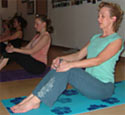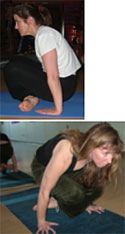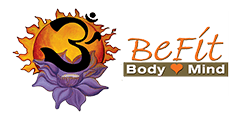Download a guide to this pose. (PDF)
Navasana (boat pose)– nava means boat, it is pronounced na-wa as most ‘V’ sounds in Sanskrit are pronounced as a ‘W’. Everyone’s favorite pose! Boat pose is about developing strength, core strength. The abdominals and hip flexors (psoas and iliacus) work together to lift the legs in this pose. The vinyasa between boat pose, lollasana, the pose where we pick ourselves up is an excellent way to strengthen the abdominals, this pose teaches us how to eventually pull through from seated to Chaturanga Dandasana without touching down.
Method:
- From Downward facing dog, hop though keeping your legs elevated off the floor, touch your sitting bones to the floor and extend your arms and legs into boat pose 😉 (This takes many years of practice to accomplish!)
|
 |
EVERYONE ELSE:
- From Downward facing dog hop through and have a seat.
- Bend your knees with the soles of your feet flat on the floor and close to your hips, catch your legs just below your knee caps, pull gently with your arms to help extend your spine. See first picture.
- Engage all your abdominals pulling inward and upward with your uddiyana bandha. Lean back lifting your legs off the floor but still gently holding on to them, rolling back slightly on the sitting bone until you feel your abdominals working to support you. See 2nd picture.
- Release your legs extend your arms at shoulder level palms facing in, see 3rd picture. If this is challenging stay here for 5 breaths, if your lower back collapses then remain in the previous pose as in 2nd picture..
- To progress; keeping your knees bent move your shins toward parallel to the floor (4th picture). You can stay here for 5 breaths or
- Continue extending your legs until they are straight, toes pointed and at eye level (5th picture). Extending your legs not only requires abdominal and hip flexor strength but hamstring flexibility as well, if you are a member of the “tight hamstring club” you will need to keep your knees bent to protect your lower back until your hamstrings lengthen. Maintain a 90o angle between your torso and legs, less angle means less strength work, too big of an angle can strain the lower back. Remain here for 5 breaths. Pay attention to not sag in the lower back, lift your heart, slide your shoulder blades down your back and pull your arms into their shoulder joints.
- Drishti is toes or nose. Lollasana (pendant pose) The Sanskrit word lolla can be translated as “fickle, frequently changing, trembling, quivering, or dangling to and fro like an earring.” Interestingly, Lolla is also another name for the goddess of fortune and wealth, Lakshmi, who represents the power of multiplicity:
- Exhaling cross your legs, ground your hands close to your hips and between your hips and feet.
- Inhaling tip forward and pick up—tuck your legs up into your body and lift your hip bones toward your ribs shortening your torso from the bottom up. Even if you can not lift off the floor it is important to try to do so. The effort of the lift is more important than getting lift off! DO NOT HOLD YOUR BREATH!
- Exhaling release downward and repeat boat pose and lollasana for a total of 5 repetitions, pulling through on the fifth lollasana for vinyasa to the next pose.

|
 |
Benefits:
Navasana is beneficial for the spinal cord, the abdominals are also strengthened and toned helping to increase digestive fire and stimulation; as a result the intestines are stimulated due to the increase in agni (digestive fire). The spinal column, anal channel, ribs and lower abdomen are all purified from this pose.



